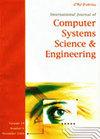求助PDF
{"title":"基于可解释人工智能的COVID-19检测的量子启发差分进化","authors":"Abdullah M. Basahel, Mohammad Yamin","doi":"10.32604/csse.2023.034449","DOIUrl":null,"url":null,"abstract":"Recent advancements in the Internet of Things (Io), 5G networks, and cloud computing (CC) have led to the development of Human-centric IoT (HIoT) applications that transform human physical monitoring based on machine monitoring. The HIoT systems find use in several applications such as smart cities, healthcare, transportation, etc. Besides, the HIoT system and explainable artificial intelligence (XAI) tools can be deployed in the healthcare sector for effective decision-making. The COVID-19 pandemic has become a global health issue that necessitates automated and effective diagnostic tools to detect the disease at the initial stage. This article presents a new quantum-inspired differential evolution with explainable artificial intelligence based COVID-19 Detection and Classification (QIDEXAI-CDC) model for HIoT systems. The QIDEXAI-CDC model aims to identify the occurrence of COVID-19 using the XAI tools on HIoT systems. The QIDEXAI-CDC model primarily uses bilateral filtering (BF) as a preprocessing tool to eradicate the noise. In addition, RetinaNet is applied for the generation of useful feature vectors from radiological images. For COVID-19 detection and classification, quantum-inspired differential evolution (QIDE) with kernel extreme learning machine (KELM) model is utilized. The utilization of the QIDE algorithm helps to appropriately choose the weight and bias values of the KELM model. In order to report the enhanced COVID-19 detection outcomes of the QIDEXAI-CDC model, a wide range of simulations was carried out. Extensive comparative studies reported the supremacy of the QIDEXAI-CDC model over the recent approaches. © 2023 Authors. All rights reserved.","PeriodicalId":50634,"journal":{"name":"Computer Systems Science and Engineering","volume":"33 1","pages":"209-224"},"PeriodicalIF":2.2000,"publicationDate":"2023-01-01","publicationTypes":"Journal Article","fieldsOfStudy":null,"isOpenAccess":false,"openAccessPdf":"","citationCount":"0","resultStr":"{\"title\":\"Quantum Inspired Differential Evolution with Explainable Artificial Intelligence-Based COVID-19 Detection\",\"authors\":\"Abdullah M. Basahel, Mohammad Yamin\",\"doi\":\"10.32604/csse.2023.034449\",\"DOIUrl\":null,\"url\":null,\"abstract\":\"Recent advancements in the Internet of Things (Io), 5G networks, and cloud computing (CC) have led to the development of Human-centric IoT (HIoT) applications that transform human physical monitoring based on machine monitoring. The HIoT systems find use in several applications such as smart cities, healthcare, transportation, etc. Besides, the HIoT system and explainable artificial intelligence (XAI) tools can be deployed in the healthcare sector for effective decision-making. The COVID-19 pandemic has become a global health issue that necessitates automated and effective diagnostic tools to detect the disease at the initial stage. This article presents a new quantum-inspired differential evolution with explainable artificial intelligence based COVID-19 Detection and Classification (QIDEXAI-CDC) model for HIoT systems. The QIDEXAI-CDC model aims to identify the occurrence of COVID-19 using the XAI tools on HIoT systems. The QIDEXAI-CDC model primarily uses bilateral filtering (BF) as a preprocessing tool to eradicate the noise. In addition, RetinaNet is applied for the generation of useful feature vectors from radiological images. For COVID-19 detection and classification, quantum-inspired differential evolution (QIDE) with kernel extreme learning machine (KELM) model is utilized. The utilization of the QIDE algorithm helps to appropriately choose the weight and bias values of the KELM model. In order to report the enhanced COVID-19 detection outcomes of the QIDEXAI-CDC model, a wide range of simulations was carried out. Extensive comparative studies reported the supremacy of the QIDEXAI-CDC model over the recent approaches. © 2023 Authors. All rights reserved.\",\"PeriodicalId\":50634,\"journal\":{\"name\":\"Computer Systems Science and Engineering\",\"volume\":\"33 1\",\"pages\":\"209-224\"},\"PeriodicalIF\":2.2000,\"publicationDate\":\"2023-01-01\",\"publicationTypes\":\"Journal Article\",\"fieldsOfStudy\":null,\"isOpenAccess\":false,\"openAccessPdf\":\"\",\"citationCount\":\"0\",\"resultStr\":null,\"platform\":\"Semanticscholar\",\"paperid\":null,\"PeriodicalName\":\"Computer Systems Science and Engineering\",\"FirstCategoryId\":\"94\",\"ListUrlMain\":\"https://doi.org/10.32604/csse.2023.034449\",\"RegionNum\":4,\"RegionCategory\":\"计算机科学\",\"ArticlePicture\":[],\"TitleCN\":null,\"AbstractTextCN\":null,\"PMCID\":null,\"EPubDate\":\"\",\"PubModel\":\"\",\"JCR\":\"Q2\",\"JCRName\":\"Computer Science\",\"Score\":null,\"Total\":0}","platform":"Semanticscholar","paperid":null,"PeriodicalName":"Computer Systems Science and Engineering","FirstCategoryId":"94","ListUrlMain":"https://doi.org/10.32604/csse.2023.034449","RegionNum":4,"RegionCategory":"计算机科学","ArticlePicture":[],"TitleCN":null,"AbstractTextCN":null,"PMCID":null,"EPubDate":"","PubModel":"","JCR":"Q2","JCRName":"Computer Science","Score":null,"Total":0}
引用次数: 0
引用
批量引用
Quantum Inspired Differential Evolution with Explainable Artificial Intelligence-Based COVID-19 Detection
Recent advancements in the Internet of Things (Io), 5G networks, and cloud computing (CC) have led to the development of Human-centric IoT (HIoT) applications that transform human physical monitoring based on machine monitoring. The HIoT systems find use in several applications such as smart cities, healthcare, transportation, etc. Besides, the HIoT system and explainable artificial intelligence (XAI) tools can be deployed in the healthcare sector for effective decision-making. The COVID-19 pandemic has become a global health issue that necessitates automated and effective diagnostic tools to detect the disease at the initial stage. This article presents a new quantum-inspired differential evolution with explainable artificial intelligence based COVID-19 Detection and Classification (QIDEXAI-CDC) model for HIoT systems. The QIDEXAI-CDC model aims to identify the occurrence of COVID-19 using the XAI tools on HIoT systems. The QIDEXAI-CDC model primarily uses bilateral filtering (BF) as a preprocessing tool to eradicate the noise. In addition, RetinaNet is applied for the generation of useful feature vectors from radiological images. For COVID-19 detection and classification, quantum-inspired differential evolution (QIDE) with kernel extreme learning machine (KELM) model is utilized. The utilization of the QIDE algorithm helps to appropriately choose the weight and bias values of the KELM model. In order to report the enhanced COVID-19 detection outcomes of the QIDEXAI-CDC model, a wide range of simulations was carried out. Extensive comparative studies reported the supremacy of the QIDEXAI-CDC model over the recent approaches. © 2023 Authors. All rights reserved.


